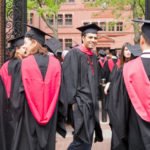Under SAT-Only Admissions, Asian American Applicants to Selective Colleges Would Gain Fewer than 3,000 Seats Out of 120,000, Georgetown University Report Finds
21% of Asian American students at the most selective colleges would not have been admitted under a test-only admissions policy
Court Cases Allege That Asian American Applicants are Held to an Unfair Standard
Critics claim that if colleges considered only academic merit, Asian American applicants would gain a greater number of seats. SFFA and other affirmative action critics often base their allegations on three factors:
- stagnant enrollment shares for Asian American students
- relatively low acceptance rates of Asian American applicants
- differences in SAT scores between Asian American and non–Asian American students at the most selective colleges.
We find all of these arguments to be unconvincing. Here’s why:
The Asian American Enrollment Share at the Most Selective Colleges Has Remained Stable Over the Past Decade
The enrollment share of Asian American and Pacific Islander students at Harvard and at the 90 other most selective colleges has kept pace with their growing share of the four-year college-going population. In fact, the Asian American and Pacific Islander share of enrollments at the most selective colleges grew by 4 percentage points even while their enrollment share at all four-year colleges grew by just 2 percentage points between 1999 and 2018.
Asian American Students are More Likely to Apply to Highly Selective Colleges Regardless of Test Scores
Among students who scored 1300 or above on the SAT, 65% of Asian American students applied to one of the most selective colleges in the country, compared to 50% of non–Asian American students. And among students who scored below 1300, 12% of Asian American students took a chance and applied to one of the most selective colleges, compared to only 5% of non–Asian American students. Since more Asian American students apply to selective colleges, they are more likely to be denied a seat, which is not evidence of bias.
There’s no strong evidence of discrimination against Asian American applicants in admissions to highly selective colleges.

cew.georgetown.edu
Let us look at the particulars in Students for Fair Admissions v. President & Fellows of Harvard College.
In this case, the contention is that Asians are discriminated against based on the number of Asians turned down for Harvard admission. More than 30,000 students each year apply to Harvard. In 2019, there were 36,000 applicants for 1,600 slots. That meant 34,400 students of all races were not admitted. The claim is Asians get excluded to add black and Hispanic students.
Harvard admission numbers do not support this claim. Asians are six percent of the American population, but they were 25.9 percent of the students entering Harvard in 2021. That is a full ten percentage points more than African Americans (15.9%) and more than double the percentage of both Hispanics (12.5%) and Native Americans (11%). In fact, there were more Asians admitted into Harvard than Hispanics and Native Americans combined.
Admissions Statistics, A Brief Profile of the Admitted Class of 2025, Harvard welcomes students from across the country and all over,
Admissions Statistics
View attachment 1079539
Who are the students of the Ivy League? In this post, we'll break down each Ivy League school by the numbers.

blog.collegevine.com



